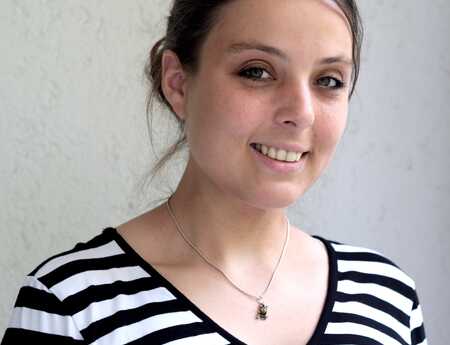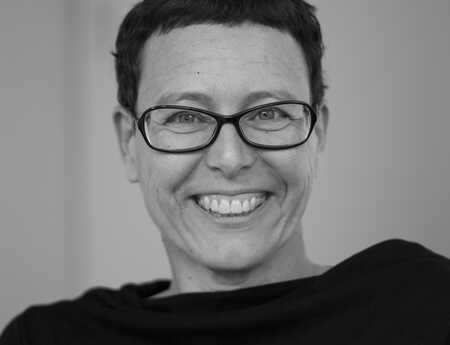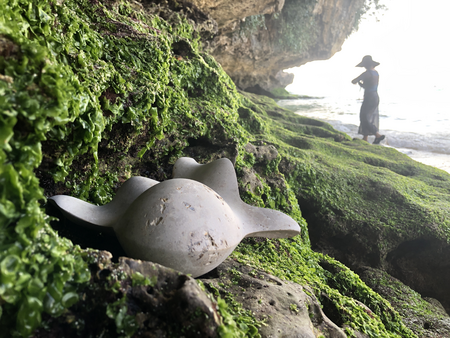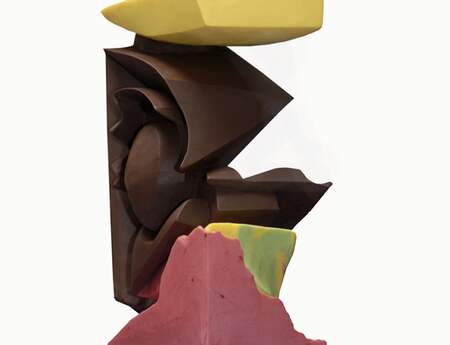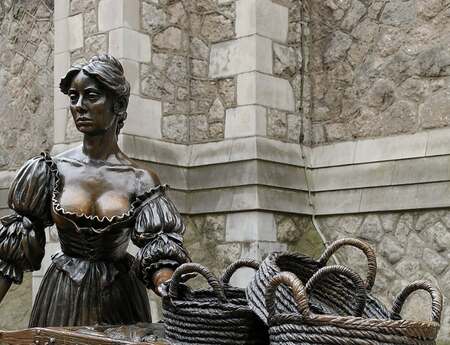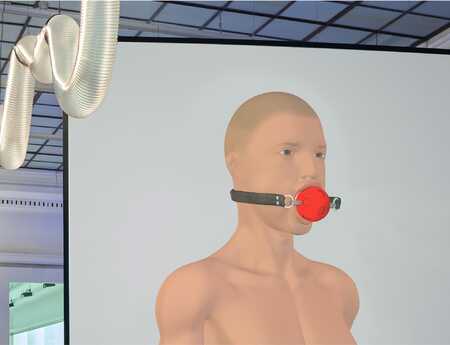Lektionen über Gewicht und Leichtigkeit, oder: Was man von einer Residency auf Bali alles mitnimmt
Monika Majer ist ausgebildete Steinmetzin und seit über 20 Jahren als freischaffende Künstlerin bei Kirchheim unter Teck tätig. Ihre Leidenschaft: Stein in all seinen Facetten. 2023 war ein spannendes Jahr für Monika, die seit 2017 Mitglied bei Sculpture Network ist: ein internationaler Kunstpreis, eine Artist Residency auf Bali und Skulpturen, die ihrem Schaffen eine neue Richtung geben. Wir haben mit Monika über diese vielen Veränderungen gesprochen.
Monika, du hast kürzlich mit deiner Skulptur ohne Weiteres (abheben) beim ArtGemini Prize 2022 den zweiten Platz belegt. Dazu erst einmal herzlichen Glückwunsch! Der Preis wurde 2022 in Singapur verliehen, also nicht gerade um die Ecke. Wie kam es dazu, dass du deine Skulptur dort eingereicht hast?
Ich habe auf Social Media die Ausschreibung für den Kunstpreis bemerkt und gesehen, dass damit eine Artist Residency auf Bali verbunden ist. Das hat mich sehr verlockt, weil es mein Wunsch ist, mehr in der Welt unterwegs zu sein. Stein ist ja überall, und mich interessiert: Welchen Stein gibt es an anderen Orten, wie gehen die Menschen damit um, welche Bedeutung hat er dort? Dass die Ausstellung der Finalist*innen in Singapur stattfindet, habe ich nicht realisiert, als ich mich beworben habe. Anfang Januar kam dann die Mitteilung: Sie sind für die Ausstellung ausgewählt, bitte schicken Sie die eingereichte Arbeit nach Singapur ... Und dann dachte ich: Hoppla, nach Singapur?
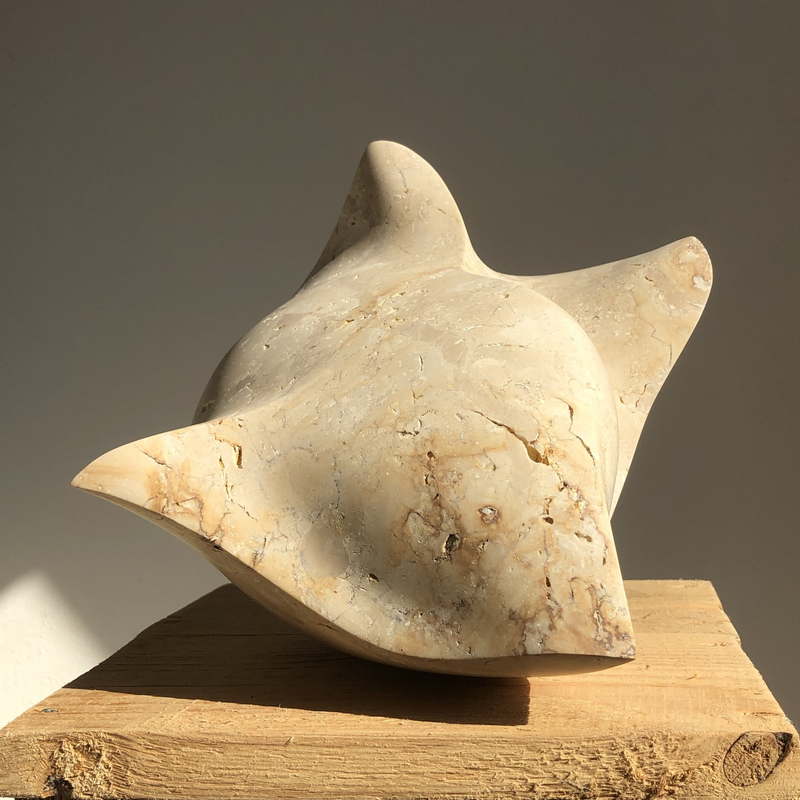
Bei einer Steinskulptur kein einfaches Unterfangen. Du hast also tatsächlich dein Werk um den halben Erdball geschickt?
Ja, tatsächlich. Ich musste mich mit ganz neuen Fragen beschäftigen: Wie verschickst du eine Skulptur nach Asien, worauf musst du achten, wer macht dir das? Es war sehr herausfordernd, vom Aufwand her und auch finanziell. Zum Glück habe ich ein gutes Netzwerk, aus dem erste Tipps von Kolleg*innen kamen, außerdem hat meine Tochter beruflich auch mit Versandthemen zu tun. Zudem gibt es in Berlin tatsächlich ein Beratungsbüro für Künstler*innen, die im Ausland ausstellen oder Artist Residencies machen, Touring Artists. Mit denen habe ich Kontakt aufgenommen, auch bezüglich der ganzen rechtlichen Geschichten und später noch mal, als ich nach Bali gegangen bin. Das fand ich sehr unterstützend. Es hat dann auch alles gut funktioniert, und am Ende habe ich mich sehr gefreut, dass die Skulptur tatsächlich ausgewählt wurde. Es war toll, mit dem Preis sozusagen belohnt zu werden für den ganzen Aufwand.
Warst du selbst in Singapur bei der Preisverleihung dabei?
Leider nicht, aber wenn ich gewusst hätte, wie teuer die Fracht ist, hätte ich mir einen Flug gebucht und die Skulptur im Handgepäck mitgenommen. Fürs nächste Mal weiß ich das.
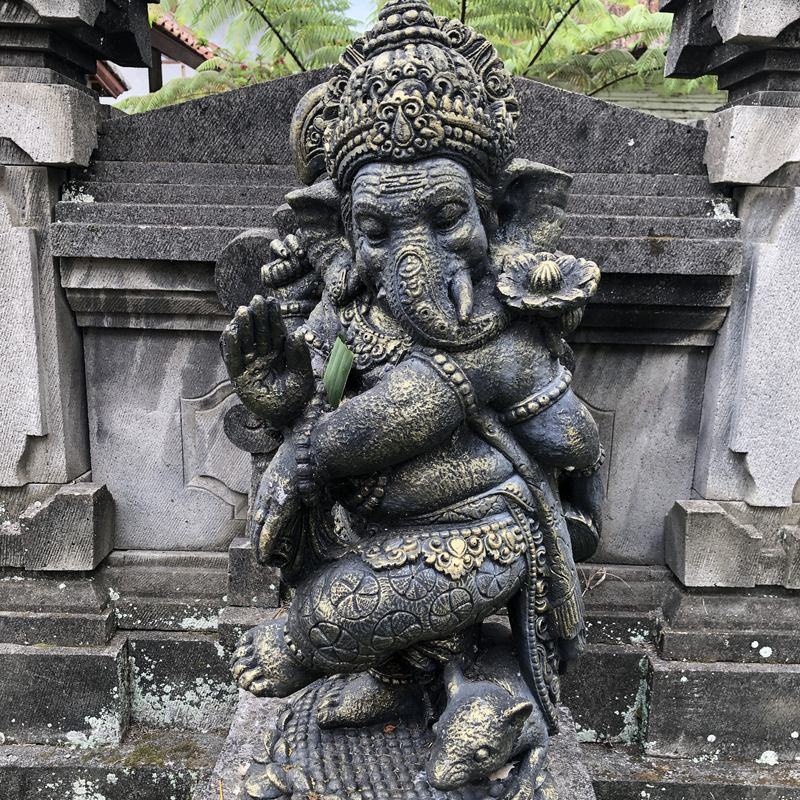
Zum Glück durftest du etwas später ja trotzdem deine Koffer packen. Für die erste und zweite Preisträgerin gab es zusätzlich einen Arbeitsaufenthalt auf Bali im Oktober. Wie hast du diese Zeit erlebt?
Sehr intensiv. Ich war noch nie in einem anderen Kulturraum, also einem nicht westlichen Kulturraum. Bali ist so ein Land, da existieren unglaubliche Gegensätze nebeneinander. Außerdem klingt es ganz anders als hier und riecht auch ganz anders. Die ganze Energie, wie die Menschen sich dort bewegen und miteinander in Verbindung sind, ist anders als hier. Ich fand es wirklich intensiv, mit dieser komplett anderen Energie, dieser ganzen Kultur umzugehen.
Was war denn die Grundidee oder vielleicht die Zielsetzung des Arbeitsaufenthalts?
Diese Artist Residency war sozusagen eine Premiere. Ermöglicht hat sie einer der Juroren des ArtGemini Prize, Benny Oentoro. Sein Anliegen war, den ersten beiden Preisträgerinnen zu ermöglichen, in eine andere Kultur hineinzuschauen und auf Bali künstlerisch tätig zu sein. Die theoretische Idee war anfangs, dass wir vier Tage auf Bali unterwegs sind und Kontakte mit regionalen Kunstschaffenden knüpfen, um ein bisschen Einblick in die Kultur zu bekommen. Dann sollten wir neun Tage Zeit haben, um an einem künstlerischen Werk zu arbeiten, und am Ende sollte es eine Ausstellung geben. So war der Plan. An Tag eins sagte Benny dann aber: „Ich glaube, mein Plan geht nicht auf. Das ist zu knapp. Wir könnten das so machen, aber es hätte keine Substanz. Ich glaube, wir brauchen mehr Zeit zum Gucken, um Begegnungen zu arrangieren, damit ihr euch überhaupt hier einfindet. Macht, worauf ihr Lust habt, und dann machen wir nächstes Jahr eine ‚proper exhibition‘.“ Also haben wir diesen Aufenthalt vom gedanklichen Ansatz her verändert: das Programm ein bisschen entzerrt, noch andere Begegnungen mit dazu arrangiert und so weiter.
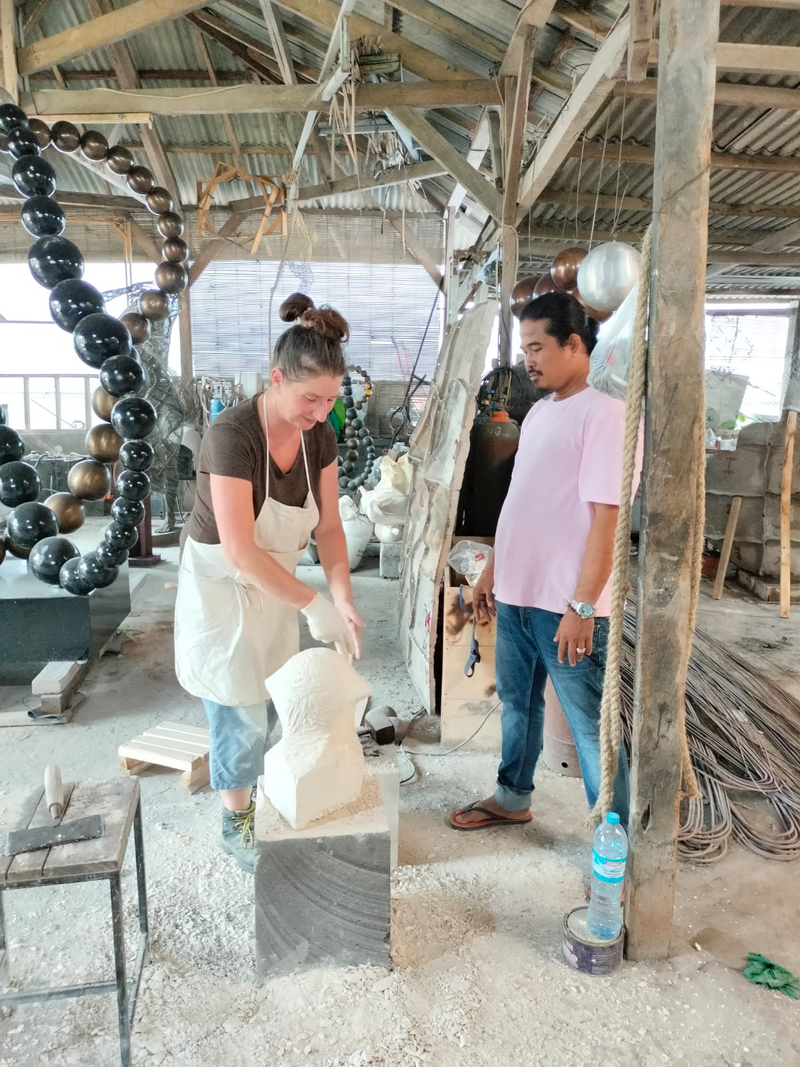
Wie genau hat sich die Arbeit vor Ort für dich gestaltet?
Es war ein bisschen lustig: Zu Anfang meinte Benny, er hätte ein schönes Hotel gefunden, wo er uns, also die erste Preisträgerin, die koreanische Malerin Jione Choi, und mich, unterbringt. Da könnten wir unsere Arbeiten anfertigen. Da habe ich gesagt: „Du, wenn ich da mit Stein anfange, dann ist es das letzte Mal, dass du da was gebucht hast.“ Daraufhin hat er einen tollen Kontakt zu einem balinesischen Bildhauer hergestellt, der ein großes Studio hat und auch international arbeitet: I Ketut Putrayasa. Er war ein riesengroßer Unterstützer. Zum einen dadurch, dass er sich sehr viel Zeit genommen hat und mir viele Einblicke gegeben hat in die balinesische Kultur und Kunst und einfach ein sehr, sehr wissender Mensch ist. Zum anderen hat er mir einen Arbeitsplatz zur Verfügung gestellt und Stein und Werkzeug. Der Druck von „Wir müssen auf eine Ausstellung hinarbeiten“ war weg, stattdessen konnte ich ausprobieren, forschen, mal gucken: Wie läuft es hier überhaupt? Wie fühlt es sich an, hier zu arbeiten?
Dabei standest du sicher der ein oder anderen Herausforderung gegenüber. Ich erinnere mich an einen Instagram-Post mit einer wegschwimmenden Skulptur …
Ich hatte einige Skulpturen von hier mitgenommen, eigentlich für die Begegnung von Kalkstein von hier mit Lavastein von dort. Nachdem ich auf Bali dann aber nicht mit Lavastein gearbeitet habe, hatte ich die Idee, wenigstens die Skulpturen vor Ort zu fotografieren. Ich wollte gucken: Was gibt es für eine Resonanz zwischen dem deutschen Kalkstein und dem, was es dort gibt, dem Fels? Also haben Benny und ich einen Ausflug an den Strand geplant. Wir waren beide völlig fasziniert davon, wie die Skulpturen dort wirkten. Der Sand dort war genau von der Farbe wie der Kalkstein auch. Und dann kommst du mit dieser Kalksteinskulptur, und der Kalkstein ist ja im Meer entstanden, und bringst sie zum Meer. Vor lauter Begeisterung darüber haben wir nicht aufgepasst. Auf einmal kam eine größere Welle und, schwupp, nimmt sie diese Skulptur mit! Sie hat tatsächlich ein Bein dabei verloren. Für mich ist so was nicht schlimm. Ich frage mich dann: Was mache ich jetzt damit, was für eine tiefere Bedeutung könnte das bekommen? An der Nordseite von Bali, wo die schwarzen Strände sind, habe ich dann später ganz feinen schwarzen Sand gesammelt und Ketut gefragt, ob er damit von dem abgebrochenen Stück einen Guss machen und das aus dem dunklen Sand gegossene verlorene Stück wieder anfügen kann. Das wird er jetzt tun.
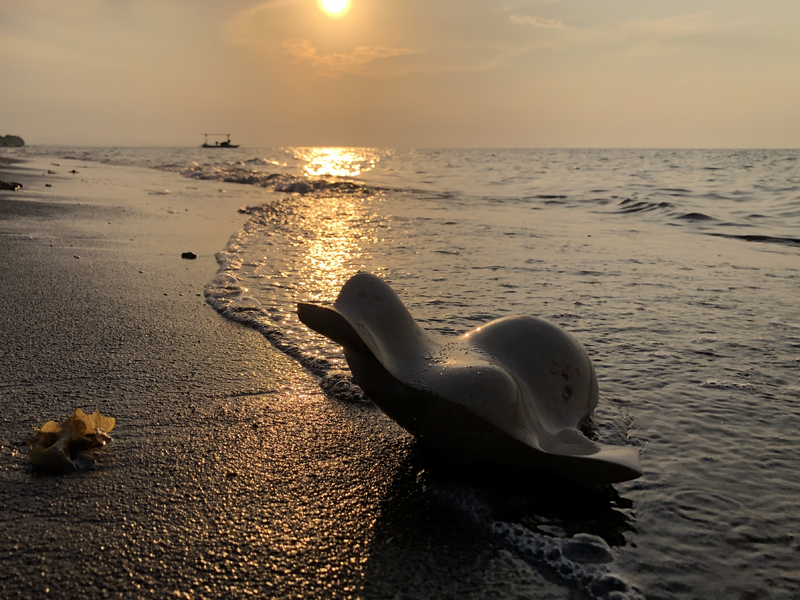
Das zeigt ja sehr schön, wie wichtig das Thema Material für dich als Bildhauerin ist. Zu Hause bei Kirchheim unter Teck arbeitest du eher mit heimischen Materialien wie Kalkstein. Wie hat sich diese Arbeit mit neuen Gesteinsarten auf Bali für dich angefühlt?
Hier arbeite ich mit dem Kalkstein, der ganz regional verfügbar ist, und auf Bali wollte ich auch mit dem Stein arbeiten, der dort ganz regional ist. Meine Grundidee war eigentlich, beides zu koppeln. Ich habe Skulpturen aus fränkischem Jura mit nach Bali genommen und wollte diese eigentlich kombinieren mit Arbeiten aus dem dortigen Lavastein. Diese verschiedenen Entstehungsgeschichten von dem Kalkstein, der durch Ablagerungen im Meer entsteht, und dem Lavastein, der aus dieser feurigen Energie, aus der Erde kommt, faszinieren mich. Der Lavastein kommt sozusagen von innen heraus, und der Kalkstein bildet sich von außen drauf. Das war eigentlich das, was mich interessiert hätte in der Theorie. In der Praxis hat es aber dann nicht funktioniert, mich dem so zuzuwenden. Ich glaube, um mich mit dem Stein an sich zu beschäftigen, hätte ich noch viel mehr Zeit gebraucht. In den zwei Wochen habe ich es erst mal nur geschafft, irgendwie klarzukommen. Es ist heiß, 80 Prozent Luftfeuchtigkeit. Ich verstehe kein Wort von der Sprache. Alles ist anders. Ich muss erst mal gucken: Wie arbeiten die Steinmetz*innen, was haben die für Werkzeuge, wie machen die das technisch? Ketut hatte mir einen balinesischen Lavastein besorgt, dann noch einen härteren Kalkstein und einen ganz weichen Kalkstein von der Nachbarinsel Java. Am Ende habe ich beschlossen: Ich arbeite jetzt einfach mit dem weichsten und am einfachsten zu bearbeitenden.
Wie unterscheiden sich denn die Arbeitsweisen und Techniken in der Steinbearbeitung auf Bali von denen, die du kennst?
Hier in Deutschland habe ich meinen Kompressor und mein Pressluftwerkzeug. Dort arbeiten die Leute von Hand, aber die Werkzeuge sind doch sehr ähnlich. Ich habe ja vor über 30 Jahren eine Steinmetzausbildung gemacht, ganz klassisch damals: ohne Pressluft, im Steinbruch, alles von Hand. Auf Bali habe ich sehr ähnliches Werkzeug vorgefunden wie das, mit dem wir hier auch arbeiten. Ich habe dort vor allem mit einem Beil gearbeitet. Ein sehr ähnliches Beil gibt es auch hier in der traditionellen Steinbearbeitung. Die Technik ist aber eine andere. Das Beil, das man hier benutzt, ist vor allem zur Oberflächenbearbeitung und wird mit beiden Händen gehalten. Auf Bali ist es eher für Grobarbeiten gedacht und wird mit einer Hand benutzt. Ich habe dann eine Kombi aus beiden Techniken gemacht, also es erst für die Grobarbeit genommen und dann ganz fein zur Oberflächenbearbeitung, was die Balines*innen so gar nicht machen. Ich habe es also teils zweckentfremdet, aber auch so genommen, wie sie es machen.
![Caption: Patuk (Balinese stone axe) and the early stages of a sculpture made of Paras Jogja (limestone from Java). © Monika Majer]](/image/2023/12/21/bild5.jpg%28mediaclass-body-media-large.f3e77e90eca3bc50a4088e9be6316e2311c9a25b%29.png)
Wie spannend, dass sich die Grundzüge in der Steinbearbeitung so stark ähneln.
Ja, das hat mich wirklich fasziniert: Ich lerne da so ein traditionelles Handwerk, und das ist am anderen Ende der Welt genauso ein traditionelles Handwerk, obwohl wir unterschiedliche Kulturen sind. Es hat mich zurückerinnert an die Wurzeln meiner eigenen Beziehung zum Stein und den Grund, warum ich mal angefangen habe, damit zu arbeiten. Man muss sich nur das Ulmer Münster anschauen – ganz ähnliche Arten von Bauteilen findest du auch am anderen Ende der Welt. Da ist es dann eben ein Tempel. Aber auch der ist aus Stein gemeißelt. Auch da sind Ornamente, auch da sind figürliche Darstellungen und Heiligendarstellungen oder eben Götter und Dämonen. Dieser Impuls, etwas zu gestalten und eine Verbindung zu suchen zu etwas Größerem, Mächtigerem als dem kleinen Menschsein, das ist so was Grundlegendes. Du kannst dich aufhalten, wo du willst, und du findest Ähnliches, was uns als Menschen ausmacht.
Inwiefern ist deine Bali-Skulptur anders als das, was du sonst machst?
Die Skulpturen, die ich von hier nach Bali mitgenommen habe, hatten das Thema: etwas mit Leichtigkeit. Es mussten kleinere Arbeiten sein, die leicht sind, wegen des Themas Fracht und Gewicht. Und da ich es eine Herausforderung finde, um die halbe Welt zu fahren und in eine andere Kultur zu gehen und vertrauensvoll zu sein, war auch innere Leichtigkeit Thema. Die Skulptur, die auf Bali entstanden ist, ist ganz anders. Sie hat diese klaren Linien – das ist etwas, das mir sehr eigen ist –, aber nicht das Liegende. Die meisten meiner Skulpturen sind eher in der Horizontalen ausbalanciert, und das ist schon eher eine vertikale Form. Sie hat auch etwas Figürliches, fast wie eine Büste.
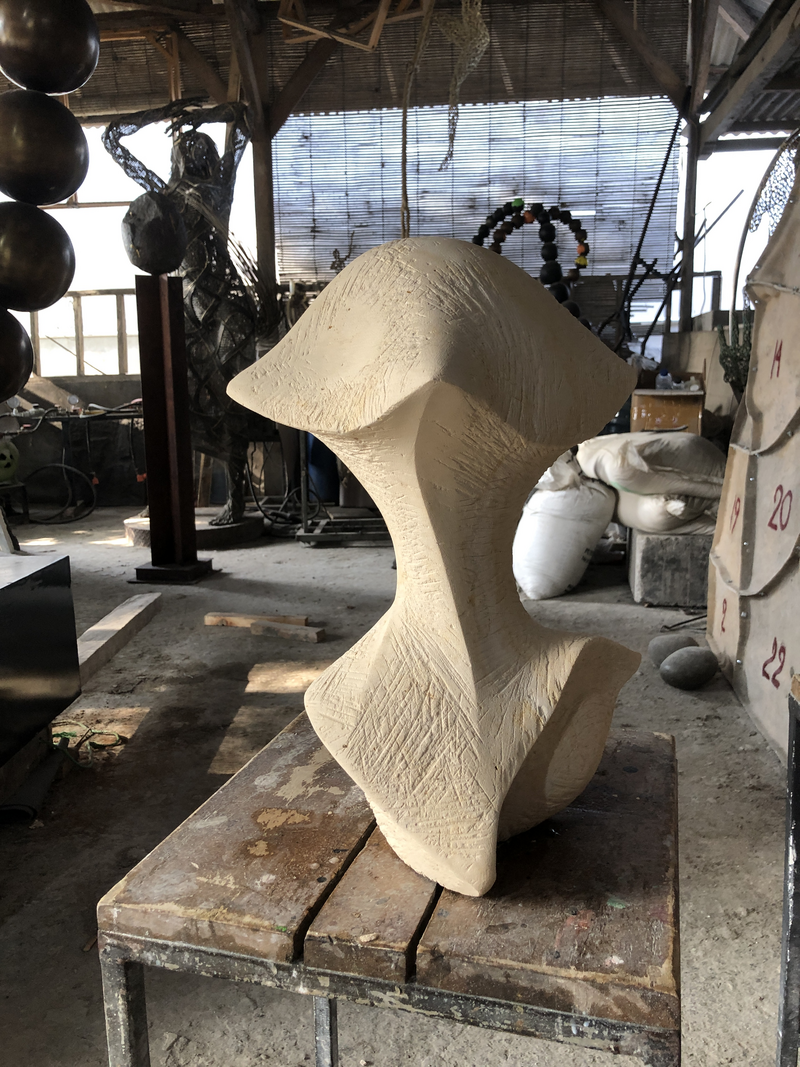
Und viel mehr Struktur als deine anderen Skulpturen. Dort sind die Oberflächen ja meist glatt.
Genau, diese starke Struktur entsteht mit dem Beil. Hier kann man schön sehen, dass die Struktur angefangen hat, die Form zu unterstützen. Das kenne ich auch aus früheren Arbeiten. Dahin bin ich ein bisschen zurückgekommen, auch durch das Werkzeug. Daneben hatte ich aber auch viele Gespräche mit Ketut. Wir haben uns zum Thema Oberfläche ausgetauscht, da ging es darum: Wie erzielt man eine Ausgewogenheit? Wenn alles mit Struktur ist, dann ist es zu viel, dann weiß man gar nicht mehr, wohin gucken. Wie kann das also gehen, dass ein Teil, wie ich es sonst auch mache, überschliffen ist und ganz fein und ein anderer Teil bearbeitet bleibt? Es war ein Versuch, einzelne Akzente zu setzen.
Wenn du jetzt ein Resümee aus diesem Arbeitsaufenthalt ziehst: Was nimmst du mit in deinen Arbeitsalltag hier?
Ich würde gern diese Arbeitsweise ein bisschen weiter fortführen. Außerdem nehme ich die Unterweisungen von Ketut mit, also Teachings zu bestimmten Themen, die die Kunst betreffen, die Symbolik betreffen, die Geometrie betreffen und so weiter. Ich habe das zwar auch mal gelernt in meiner Ausbildung und im Studium der Gestaltung und habe auch eine Zeit lang sehr bewusst nach diesen Grundsätzen gearbeitet, das aber irgendwann mal beiseitegetan und mache es inzwischen intuitiv. Jetzt will ich mir selbst bestimmte Entscheidungen wieder bewusster machen, die ich schon intuitiv treffe, auch in Bezug auf Form. Genau gucken: Wohin verweist mich das? Oder wohin verknüpft mich das auch bezüglich der Symbolik, die zugrunde liegt? Ich glaube schon, dass wir alle aus so einer Art kollektivem Wissen schöpfen. Wenn etwas über Jahrtausende hinweg immer wieder auftaucht, als Form oder als Symbol, dann, glaube ich, muss es ja irgendwo verankert sein.
Vielen Dank, Monika, dass du diese spannenden Einblicke mit uns geteilt hast. Eine kleine Abschlussfrage hätte ich noch: Was ist es, was Sculpture Network dir persönlich als Künstlerin gibt?
Als Künstlerin gibt es mir vor allem diese Kontakte zu anderen Skulpturschaffenden. Ich finde es besonders, dass es eben ein Sculpture Network ist. Es ist etwas anderes, sich mit einer Malerin zu unterhalten als mit einer Bildhauerin, das ist einfach eine Dimension dazu – dreidimensional eben.
Weitere Informationen zur Künstlerin: Website Monika Majer

